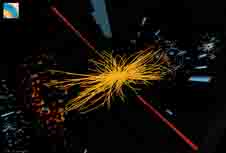3Qs: Searching for the “Holy Grail” of physics

Researchers at CERN, the European Center for Nuclear Research, reported earlier this week they are getting closer to discovering the Higgs boson, a subatomic particle that scientists believe will explain why everything in the universe has mass. The Higgs boson is considered to be the “Holy Grail” of particle physics, and finding it would be one of the greatest scientific advancements in decades.
The research team at CERN includes Northeastern University graduate student David Nash, undergraduate co-op student Edward Vaisman and post-doctoral researcher Daniele Trocino. Northeastern physics professors George Alverson, Emanuela Barberis and Darien Wood are also involved in the project, along with other graduate students and post-doctoral associates. We asked Barberis, associate professor of physics, to explain the Higgs boson and what its discovery would mean to the world’s scientific community.
What is the Higgs boson, and why is it significant?
Imagine a universe without mass. Without a Higgs boson, the theory of the smallest building blocks of matter would only describe them as massless. We know that this is not possible, as objects around us do have mass, so there has to be a mechanism, such as the interaction with the Higgs boson, from which these fundamental constituents acquire their mass.
If the Higgs boson is discovered, what impact will it have on the field of physics?
Uncovering the mechanism for the generation of mass is one of the great open questions in physics. Experiments have been looking for a Higgs particle for the past 50 years. Discovering a Higgs particle and measuring its properties will further our understanding of how the universe developed just after the Big Bang and set the course for future experiments and theoretical development.
Is the Higgs boson the only explanation for why things have mass? What if researchers are not able to find it?
No, the Higgs boson is the simplest mechanism, but there are other theoretical models that attempt to explain mass without it. With more data, we should be able to either find it or to start seeing deviations in some very high-energy processes, indicative of the presence of other underlying mechanisms.





